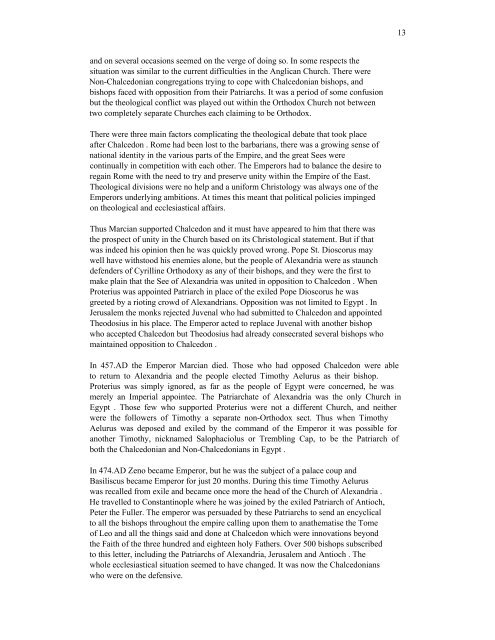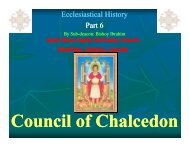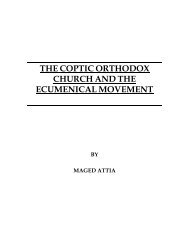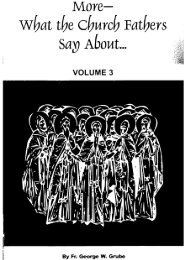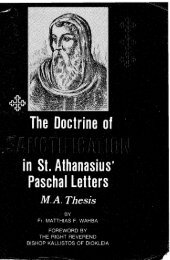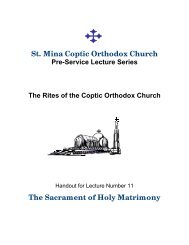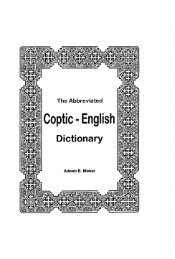Coptic interpretations of the Fourth Ecumenical Council - Saint Mina ...
Coptic interpretations of the Fourth Ecumenical Council - Saint Mina ...
Coptic interpretations of the Fourth Ecumenical Council - Saint Mina ...
Create successful ePaper yourself
Turn your PDF publications into a flip-book with our unique Google optimized e-Paper software.
and on several occasions seemed on <strong>the</strong> verge <strong>of</strong> doing so. In some respects <strong>the</strong><br />
situation was similar to <strong>the</strong> current difficulties in <strong>the</strong> Anglican Church. There were<br />
Non-Chalcedonian congregations trying to cope with Chalcedonian bishops, and<br />
bishops faced with opposition from <strong>the</strong>ir Patriarchs. It was a period <strong>of</strong> some confusion<br />
but <strong>the</strong> <strong>the</strong>ological conflict was played out within <strong>the</strong> Orthodox Church not between<br />
two completely separate Churches each claiming to be Orthodox.<br />
There were three main factors complicating <strong>the</strong> <strong>the</strong>ological debate that took place<br />
after Chalcedon . Rome had been lost to <strong>the</strong> barbarians, <strong>the</strong>re was a growing sense <strong>of</strong><br />
national identity in <strong>the</strong> various parts <strong>of</strong> <strong>the</strong> Empire, and <strong>the</strong> great Sees were<br />
continually in competition with each o<strong>the</strong>r. The Emperors had to balance <strong>the</strong> desire to<br />
regain Rome with <strong>the</strong> need to try and preserve unity within <strong>the</strong> Empire <strong>of</strong> <strong>the</strong> East.<br />
Theological divisions were no help and a uniform Christology was always one <strong>of</strong> <strong>the</strong><br />
Emperors underlying ambitions. At times this meant that political policies impinged<br />
on <strong>the</strong>ological and ecclesiastical affairs.<br />
Thus Marcian supported Chalcedon and it must have appeared to him that <strong>the</strong>re was<br />
<strong>the</strong> prospect <strong>of</strong> unity in <strong>the</strong> Church based on its Christological statement. But if that<br />
was indeed his opinion <strong>the</strong>n he was quickly proved wrong. Pope St. Dioscorus may<br />
well have withstood his enemies alone, but <strong>the</strong> people <strong>of</strong> Alexandria were as staunch<br />
defenders <strong>of</strong> Cyrilline Orthodoxy as any <strong>of</strong> <strong>the</strong>ir bishops, and <strong>the</strong>y were <strong>the</strong> first to<br />
make plain that <strong>the</strong> See <strong>of</strong> Alexandria was united in opposition to Chalcedon . When<br />
Proterius was appointed Patriarch in place <strong>of</strong> <strong>the</strong> exiled Pope Dioscorus he was<br />
greeted by a rioting crowd <strong>of</strong> Alexandrians. Opposition was not limited to Egypt . In<br />
Jerusalem <strong>the</strong> monks rejected Juvenal who had submitted to Chalcedon and appointed<br />
Theodosius in his place. The Emperor acted to replace Juvenal with ano<strong>the</strong>r bishop<br />
who accepted Chalcedon but Theodosius had already consecrated several bishops who<br />
maintained opposition to Chalcedon .<br />
In 457.AD <strong>the</strong> Emperor Marcian died. Those who had opposed Chalcedon were able<br />
to return to Alexandria and <strong>the</strong> people elected Timothy Aelurus as <strong>the</strong>ir bishop.<br />
Proterius was simply ignored, as far as <strong>the</strong> people <strong>of</strong> Egypt were concerned, he was<br />
merely an Imperial appointee. The Patriarchate <strong>of</strong> Alexandria was <strong>the</strong> only Church in<br />
Egypt . Those few who supported Proterius were not a different Church, and nei<strong>the</strong>r<br />
were <strong>the</strong> followers <strong>of</strong> Timothy a separate non-Orthodox sect. Thus when Timothy<br />
Aelurus was deposed and exiled by <strong>the</strong> command <strong>of</strong> <strong>the</strong> Emperor it was possible for<br />
ano<strong>the</strong>r Timothy, nicknamed Salophaciolus or Trembling Cap, to be <strong>the</strong> Patriarch <strong>of</strong><br />
both <strong>the</strong> Chalcedonian and Non-Chalcedonians in Egypt .<br />
In 474.AD Zeno became Emperor, but he was <strong>the</strong> subject <strong>of</strong> a palace coup and<br />
Basiliscus became Emperor for just 20 months. During this time Timothy Aelurus<br />
was recalled from exile and became once more <strong>the</strong> head <strong>of</strong> <strong>the</strong> Church <strong>of</strong> Alexandria .<br />
He travelled to Constantinople where he was joined by <strong>the</strong> exiled Patriarch <strong>of</strong> Antioch,<br />
Peter <strong>the</strong> Fuller. The emperor was persuaded by <strong>the</strong>se Patriarchs to send an encyclical<br />
to all <strong>the</strong> bishops throughout <strong>the</strong> empire calling upon <strong>the</strong>m to ana<strong>the</strong>matise <strong>the</strong> Tome<br />
<strong>of</strong> Leo and all <strong>the</strong> things said and done at Chalcedon which were innovations beyond<br />
<strong>the</strong> Faith <strong>of</strong> <strong>the</strong> three hundred and eighteen holy Fa<strong>the</strong>rs. Over 500 bishops subscribed<br />
to this letter, including <strong>the</strong> Patriarchs <strong>of</strong> Alexandria, Jerusalem and Antioch . The<br />
whole ecclesiastical situation seemed to have changed. It was now <strong>the</strong> Chalcedonians<br />
who were on <strong>the</strong> defensive.<br />
13


